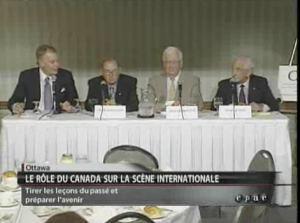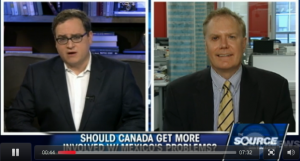excerpted from June 30, 2011 Winnipeg Free Press Canada Day in D.C. just one victim of cuts to embassy hospitality budgets by Lee-Anne Goodman, The Canadian Press
WASHINGTON – The downsizing of the annual Canada Day celebrations at Canada’s flagship embassy in the U.S. capital may seem like sensible belt-tightening to some, regardless of the griping by ex-pats about this year’s much smaller Pennsylvania Avenue shindig.
But Canadian diplomats past and present say it’s a symptom of a much bigger problem: the Conservative government slashing of hospitality budgets at embassies and high commissions around the world, which they warn is dramatically hindering Canada’s ability to drum up trade, advance Canadian interests and raise the country’s international profile.
“I can only tell you we are in a period of fiscal restraint,” Alain Cacchione, a spokesman for the Department of Foreign Affairs and International Trade, said in an email Thursday when asked about the downsizing. He provided no further comment.
The current state of affairs seems a decided shift in attitude from Jean Chretien’s years in power.
The former prime minister often asserted that “you don’t do diplomacy out of your basement.” Stephen Harper, the diplomats suggest, seems to disagree.
“Bottom line is that you can’t do diplomacy without a budget to market and influence,” said Colin Robertson, a former senior diplomat who was known as a master of Capitol Hill networking during his years at the Canadian embassy in Washington.
“We generate over a million dollars a minute in trade with the U.S., yet we are faced with a thickening border. The investment by our embassy and consulates in reaching out to legislators and businesses — who will then pressure their legislators — is minuscule compared to the trade and relationship at stake.”
The Canada Day event may seem like small potatoes, but it’s a chance for Canada to publicly sell itself in the most powerful nation on Earth, Robertson added.
The event traditionally features a barbecue, with Canadian treats like beaver tails and poutine also on offer and Canuck beer available for tipplers. A Canadian musical act usually performs and RMCP officers in their iconic scarlet serges mingle with the party-goers.
American legislators are on the invite list and often show up for the festivities. Three years ago, the Washington Capitals hockey squad was in attendance.
“Canada Day is the ideal occasion to bring together people in business and government around Canadian beer, Canadian chips from Canadian potatoes, and Canadian burgers from Canadian beef — all products that have successfully found a market in the U.S. because we actually marketed,” Robertson said.
Canadian heads of mission were stunned during a conference call in July 2009 when they were told that the so-called program budgets for all missions were being immediately slashed by 50 per cent. Many ambassadors and high commissioners were already struggling after being ordered to cut their budgets a year earlier by 25 per cent.
Among other things, program budgets pay for diplomats to attend and host events and to travel beyond the embassy, as well as for public diplomacy efforts and human rights initiatives.
Since then, diplomats have complained to Foreign Affairs that the cuts have made it difficult for them to make crucial contacts and build solid relationships abroad.
Lawrence Cannon, who was foreign affairs minister at the time, defended the cuts as “a re-allocation process to make sure resources are being used as effectively as possible.” Government officials also insisted embassies could be flexible and prioritize so that missions could continue to advance Ottawa’s objectives without a problem.
That apparently has not been the case.
In Washington in the aftermath of the cuts, Canadian diplomats could not attend a security conference because they couldn’t afford the US$30 entrance fee, let alone travel outside D.C. to the 50 American states.
It was a similar situation in embassies around the globe.
“In every Canadian embassy around the world, the gates came down,” said one Canadian diplomat stationed abroad who requested anonymity.
“All of a sudden, it was: ‘Sorry, we’re broke. There’s no more money for you for anything.’ We were all blown away. Some colleagues couldn’t do their jobs any more. We’re supposed to be a G8 country, but sometimes we act like we’re in the little leagues.”
Paul Frazer, a one-time diplomat who now heads a consulting business in the U.S. capital, said the Canadian embassy in D.C. in particular — located almost next door to the Capitol building — was meant for entertaining.
“It was in fact designed precisely for the purpose of hospitality. It has all sorts of reception rooms, a spacious terrace overlooking the Capitol, and it’s located in a spot that was meant to encourage legislators and their staff to come by and meet with the Canadian mission.”
Slashing the D.C. budget to the same extent as other missions around the world made little sense, Frazer added, given the importance of the Canada-U.S. trade relationship. He points the finger at those who mind the purse strings.
“We aren’t talking about lavish feasts or parties; they don’t happen anymore and they haven’t in years and years and years,” he said.
“But if you’re sitting in Ottawa, hospitality for a lot of those bean-counters might seem a foolish, wasteful expense. When it’s managed properly, however, it can be extremely effective and one of the most important elements of diplomacy.
“Those out in the field know that, but the bean-counters don’t.”


